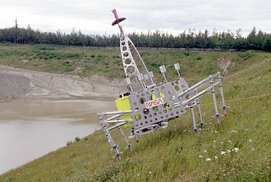

If manufacturers wait until their robots break before they perform maintenance, their production lines can be down for a long and costly amount of time. A team of five partners from universities and industry pulled the technology together to develop a robot monitoring tool that alerts any problems before they become too costly. The ROBCOM project found a clever mix of sensors and signal processing which was then tested both in the laboratory and in action, in industry.
Robots are an important part of the modern manufacturing industry. Automation removes human exposure to dangerous working conditions and it can make production much more efficient.
Many robot users adopt a "fix it when it breaks" approach to maintenance. Repair work is only carried out when the robot fails and causes an unexpected and costly interruption in production. The ROBCOM (Robot Condition Monitoring) project team decided to develop an integrated on-line and off-line expert system to monitor the condition and evaluate the performance of industrial robots. This system can detect and classify incipient failures or decalibration trends of the robot before any major problems occur. As a result, production time lost through robot maintenance is minimised.
Which faults to monitor?
The five project partners, from both industry and universities, began by selecting a set of relevant robot errors. They first chose the errors that occur most frequently in industry such as backlash in gear transmission, gear wobble and bearing problems amongst others. The team then considered whether or not it would be possible and useful to simulate and analyse the errors within the project. Some of the defects, for example, are too application dependent or could not be simulated without damaging the robot.
With their list of errors, the partners selected sensors that would be able to make the appropriate measurements. These included measuring vibrations, the power consumption and speed of the robot motors and the robot's end-point position.
Besides detecting deviations from normal robot behaviour, the new system should also be able to trace back to the cause of the anomaly. To be able to do this on-line, it is necessary to incorporate a lot of sensors and this raises the cost, as well as decreasing the possibilities to apply the system in industry. The chosen system allows the user to perform on-line monitoring with a limited number of sensors. When defects are detected, the system will suggest some new, sometimes off-line measurements.
Tapping the potential of new technology
To characterise, detect and quantify the errors in the machine, the project team developed several well-known and innovative signal processing techniques to detect and quantify errors. The final expert system was successfully evaluated on a test robot that had a series of defects. The tool gives a report on the current status of the robot and, in conjunction with the developed test procedures, advice for further action. Along with these laboratory tests, an industrial test bed of robots allowed the researchers to evaluate the system in a more realistic environment and to evaluate the overshoot behaviour of robots.
"The know-how and the experience gained through this project showed that the approach is promising and that it is general enough to be applied on different robots and even on different machinery when it is correctly tuned," says Hendrik Van Brussel, the project's coordinator. In general, the systems, with easy-to-use menu structures to guide users through the mathematical toolbox, will be applied to enhance quality control in industry - mainly the automotive sector.
Everyone's a winner
The partners complementary skills and backgrounds were a major part of the project's success. All have plans to make use of the results in different ways appropriate to their own business or research activities. Krypton Electronic Engineering in Belgium will broaden their product range by incorporating the robot condition monitoring methodologies into their existing products. They are setting up a predictive maintenance strategy for industrial robots. Current sales estimations for two of the systems are 10 sales per year at 30,000 ECU per unit and 50 at 12,000 ECU per unit.
Data Analysis Products, a Belgian consultancy, are applying the know-how they gained to serve their customers. This will help communicate the results to industry. Depending on the feedback they receive, they will sell the system of the further developed product. The industrial partner, Reis, is improving their in-house quality assurance and giving their clients better information about their products.
Partners from the research community, the Katholieke Universiteit Leuven and CIM Centrum Delft, will also continue their work. The former is pushing the results forward into the field through networks and other projects. They will also form the basis of future PhD and Master degree theses and make an appearance in lecture courses. The latter also plans to teach some of the results in its courses and will complete follow-up work in new research.
To find out more please
Click here.









